|
Volume 61
16 Janurary 2002
El Salvador
We liked our
El Salvador experience. It is hard to say what the formula is for
taking to a place. For sure geography makes a strong first impression,
and the coastline of eastern El Salvador as dawn revealed it, presented
an appealing line of volcanoes the color of a lion's pelt with a
belt of green mangroves below. Our thirty-hour trip from Nicaragua
across the mouth of the Gulf of Fonseca had been very smooth, with
a full moon for the night hours, no traffic anxieties, and very
little wind. We were quite mellow as we glided up to a rendezvous
waypoint where a panga from Barillas Marina met us to lead us in
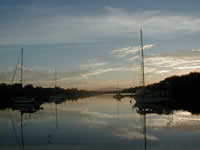 through
the barrier reef and ten miles up a maze of sandy islets and mangrove
waterways. through
the barrier reef and ten miles up a maze of sandy islets and mangrove
waterways.
Barillas Marina
is a very new facility, not yet two years old. It is not precisely
what we think of as a marina. There are no docks or slips, but rather
a mooring field lining the sides of a long mangrove channel. A quite
ambitious mooring field in fact with seventy-five balls available!
On shore there is a perfectly manicured compound with a pool, a
big jacuzzi, poolside palapas (little thatch "umbrellas")
wired for laptop Internet hook-ups, a restaurant, a tiny convenience
store, an air-conditioned computer room with at least a dozen machines,
a fuel dock and a laundry service. While much of this is targeted
to transient cruisers, Barillas is also a retreat for privileged
Salvadorans (including the President who was around when we arrived
New Year's Eve and who personally greeted the cruisers who came
in two days before us.) There are extensive locking sheds for locals
to dry-store their power boats along with a very well conceived
launching system, there are rooms somewhere, and there is a helicopter
pad and a grass airstrip so the owner and other members can fly
in. All this is enclosed by high fencing and is patrolled by armed
guards (especially, of course, when the President is here.) 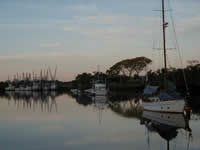
In a part of
the world that cruisers have traditionally passed by in long multi-day
passages, Barillas' reputation obviously spread quickly through
the grapevine as a good place for a rest. Marketing-wise management
was very shrewd offering free mooring to the first hundred cruisers
to stop. This drew in many yachts, most of them southbound from
the West Coast.
Then, last January
and February two devastating earthquakes struck the country. The
January 13 quake registered 7.6 on the Richter scale and thousands
were left homelss. At Barillas, the cruisers rallied to set up a
major relief effort with fundraising tentacles that reached out
north and south on the radio nets. This led to an ambitious construction
effort where North American cruisers organized, instructed, imported
materials and equipment, and even labored alongside the locals to
build new, earthquake-resistant housing for families left homeless
who not only would have had no other source of help, but who in
fact had been turned off the land where their homes originally had
stood by property owners who didn't want them to rebuild. Obviously,
this relief effort was an impressive investment of time, energy
and emotion, keeping many cruisers involved for months.
There was a
small backlash from this, a sense by those cruisers of being caught
in a golden cage. The marina, set amongst the mangroves and surrounded
outside the fence by a huge agricultural plain, is a long way from
anywhere. And, although the daily mooring fee was very low, prices
for services - laundry, Internet, food, etc. -- were not so low.
It's an old story. Now, too there is competition from Bahia del
Sol, a resort farther west, with a reportedly more laid-back attitude
and much quicker, cheaper and less-controlled access to the city
of San Salvador. Its chief problem is a seriously risky entrance
through the surf for slow moving sailboats.
So, we weren't
at all sure of how we would react to Barillas, but I must confess,
we liked it right well, golden cage and all. To start with the boat
sat quietly 24 hours a day, with very cool nights making for exceptional
sleeping. With coffee we could enjoy a fabulous parade of bird life
- great egrets, snowy egrets, little blue herons, tri-colored herons,
kingfishers, whimbrels and sandpipers -- working the mud flats around
the mangroves very near at hand. Several mornings Don and I went
in and walked outside the compound along the ready-to-harvest sugar
cane fields and through old coconut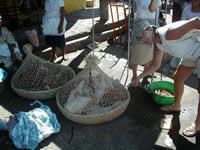 plantations with hump-backed cattle grazing below. In the afternoons,
all the cruisers present would gather at the pool to sit in cool
water and sip cool beverages. Twice a week, a free shuttle would
convey us into Usulutan, a bustling provincial town with a decent
supermarket, a fabulous maze of streets stalls selling everything
including nice vegetables and unusual eats, and a good chicken "fast-food"
restaurant. All in all it was quite addicting and the days just
slipped by.
plantations with hump-backed cattle grazing below. In the afternoons,
all the cruisers present would gather at the pool to sit in cool
water and sip cool beverages. Twice a week, a free shuttle would
convey us into Usulutan, a bustling provincial town with a decent
supermarket, a fabulous maze of streets stalls selling everything
including nice vegetables and unusual eats, and a good chicken "fast-food"
restaurant. All in all it was quite addicting and the days just
slipped by.
One reason we
chose to go to Barillas was its reputation as a secure place to
leave the boat while doing inland travel. We had heard a great deal
about Guatemala and how it shouldn't be missed, but we had also
heard that stopping in Puerto Quetzal, Guatemala's Pacific port,
entailed extremely expensive fees. Barillas had a tour operator
they endorsed and we coerced Patricia and Don of the southbound
yacht Ragtime to test them out with us in a day trip to San Salvador.
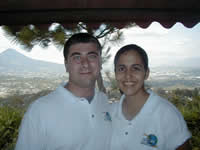 Celina
and Max of Discover El Salvador turned out to be the absolute highlight
of our visit. No sooner was their nice new air-conditioned van outside
the gates, than Celina's articulate and passionate understanding
of her country and its history made itself evident. We started simply
with a lesson on sugar cane, how it is planted (Sections of cane
containing two nodules are planted in the ground, and new plants
sprout from the nodules.), how it grows (A cane field is harvested
once a year for four years before replanting.) and how it is harvested
(They burn the field in the afternoon to rid the cane of its razor
sharp foliage and the snakes and tarantulas that thrive there, before
the harvesters, men and women swathed head to toe in clothing, come
in the next morning to cut the canes with machetes.) Anyone cruising
in Central America in the dry season quickly becomes familiar with
the fallout from this burning, large tendrils of black ash that
accumulates in maddening piles all over the boat. Celina
and Max of Discover El Salvador turned out to be the absolute highlight
of our visit. No sooner was their nice new air-conditioned van outside
the gates, than Celina's articulate and passionate understanding
of her country and its history made itself evident. We started simply
with a lesson on sugar cane, how it is planted (Sections of cane
containing two nodules are planted in the ground, and new plants
sprout from the nodules.), how it grows (A cane field is harvested
once a year for four years before replanting.) and how it is harvested
(They burn the field in the afternoon to rid the cane of its razor
sharp foliage and the snakes and tarantulas that thrive there, before
the harvesters, men and women swathed head to toe in clothing, come
in the next morning to cut the canes with machetes.) Anyone cruising
in Central America in the dry season quickly becomes familiar with
the fallout from this burning, large tendrils of black ash that
accumulates in maddening piles all over the boat.
Our next lesson
became a bit more complicated as she went into the history of the
land we were driving through. All of it, from the mangroves to the
base of the volcano, surely thousands of acres, once belonged to
one family - the Wrights. El Salvador, like its other Central American
neighbors (including Mexico, of course) has a history of serious
economic stratification, with the educated rich getting seriously
richer and the indigenous peoples getting increasingly disenfranchised.
Prevalent throughout Central American history are stories of greed
and corruption enhancing this trend. This, and racial hierarchy,
are the simple foundations of the tides of repression and revolution
that have swept this part of the world since the takeover by the
Spanish in the 16th century. I'm not going to touch here on the
politics or human rights violations that raged here in the recent
war years. It is truly frightening to try to comprehend. But during
that time were also enacted land reforms, where much property was
confiscated by the government from landowners and redistributed,
at least in theory, to cooperatives among the poor. On paper, it
has a ring of justice. And indeed many of the former plantation
owners were guilty of abusive use of their labor. But not all. The
Wrights, by all accounts, were different. Their plantation was a
model of progressive practices, using relatively modern agricultural
techniques and taking good care of their workers and their families,
including providing schools and clinics. None-the-less their land
and their homes were taken from them, and given to the cooperatives
(and, of course, to cronies of those then in power). It is clear
that farm buildings that were once fine are falling into disrepair.
The cooperatives do not have the capital, the education, the vision
or the management skills to keep things up and to grow. Juan Wright,
the son, has since made efforts to get some of his family's property
back, and this includes the mangrove land on which he has built
Barillas Marina. However, further efforts to reacquire agricultural
land, which is coming up for sale by the failing cooperatives, has
been blocked. We, of course, had met Mr. Wright, known by his first
name and well-liked among the cruisers, and we had heard only good
things about his support of the cruisers' relief efforts after the
earthquake.
All this was
food for thought as we arrived in the capital city of San Salvador.
We were surprised to find it an attractive, fairly modernized city,
threaded through by small parks and rotaries with old and new sections,
and, of course, rich and poor sections. We had a sampling of El
Salvador's handicrafts at an artisan's collective, a very important
section of which was inspired by an artist named Fernando Llort
in a village in the northern part of the country called Las Palmas.
Celina took us to Llort's gallery in San Salvador in preparation
for seeing his restoration work to the façade of the Catedral
Metropolitana in the city's center. We did other tourist type sightseeing
(including a stop at Price Smart near the American embassy) before
ending up for lunch at Patty's Pupuseria, an unpreposessing eatery
high atop a hill overlooking the city. Here we got to try the best
of an El Salvadoran staple, pupusas. Pupusas are a sort of fat corn
tortilla stuffed with meat, cheese and/or beans and eaten with scoops
of a pickled cabbage salad. We even got to go back into the kitchen
to see how they were made.
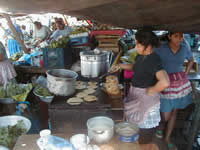 Over
our pupusas, we finally got Celina's personal story pieced together
(Max, who drives the van, is actually Italian and only three years
in El Salvador) which added depth to everything we were seeing.
Celina's father, educated as an engineer, was mayor of San Salvador
during part of revolution. After three unsuccessful assassination
attempts, he and his wife were spirited out of the country by the
CIA. America apparently believed unrealistically that the El Salvador
"situation" would be resolved in several months, so the
children were left behind. However, after an unsuccessful kidnapping
attempt, their aunt got them out to the US, where Celina and her
family lived for six years. Although trained as an engineer, her
father could not get any work better than construction rehab, and
chemicals he was exposed to brought about a serious downturn to
his health. Because the doctors thought he was dying of leukemia,
he took the first opportunity after the war to return to his homeland
with his family…where, miraculously he recovered totally! Over
our pupusas, we finally got Celina's personal story pieced together
(Max, who drives the van, is actually Italian and only three years
in El Salvador) which added depth to everything we were seeing.
Celina's father, educated as an engineer, was mayor of San Salvador
during part of revolution. After three unsuccessful assassination
attempts, he and his wife were spirited out of the country by the
CIA. America apparently believed unrealistically that the El Salvador
"situation" would be resolved in several months, so the
children were left behind. However, after an unsuccessful kidnapping
attempt, their aunt got them out to the US, where Celina and her
family lived for six years. Although trained as an engineer, her
father could not get any work better than construction rehab, and
chemicals he was exposed to brought about a serious downturn to
his health. Because the doctors thought he was dying of leukemia,
he took the first opportunity after the war to return to his homeland
with his family…where, miraculously he recovered totally!
Celina and Max
work very hard at presenting a totally professional impression,
but we ladies put two and two together to figure out that Celina
and Max were, in fact, a couple. This led us to learning a bit about
their lives, their children, about local education, and their struggle
to make their business a success. Meanwhile, in the front seat,
Don discovered that Max had recently gotten his private pilot's
license and was chipping away at higher ratings when funds allowed.
This past year has been very tough on them with the first earthquakes
quashing the spurt of reservations they had building and more recently
the general slowdown on travel resulting from 9/11. I think we cruisers
were profoundly struck by the fact that two such hard-working and
educated people had no guarantees of a smooth road. Despite economic
stratification, there certainly are some people caught in the middle.
After our San
Salvador outing, Don and I were very keen to do a trip to Guatemala
if we could make it happen with Celina and Max, but unfortunately
the economics of a tour for just two of us wasn't feasible and we
couldn't get any of the other cruisers in the marina interested.
The only alternative for us was either long hours on the bus or
pricey air flights, neither of which held the same attraction. Plus,
it was never far from our minds that the crossing of the Gulf of
Tehuantepec still stood between us and our continued passage north.
The Gulf of Tehuantepec is the Pacific side of the low, narrow isthmus
at the southern end of Mexico across which infamous winds of gale
force blow formuch of the dry season (Decem ber to April). Our delay
in getting 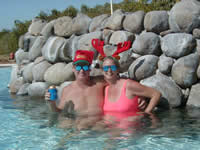 through
Costa Rica positioned us to face this crossing at just about the
worst time of year possible, since pilot charts predict gale force
wind at least twenty days out of the month in January. From Barillas,
it would be, at best, a four day trip. through
Costa Rica positioned us to face this crossing at just about the
worst time of year possible, since pilot charts predict gale force
wind at least twenty days out of the month in January. From Barillas,
it would be, at best, a four day trip.
However, analysis
of weather faxes was suggesting a weather window might be opening
up at the end of the week, and although we thought it unlikely we
would get all the way, it looked a good enough opportunity that
we had to turn away from temptations and face practicalities. I
can't tell you how hard it was for us to pull away from the settled
nights and the poolside social life. You would think we would have
gotten bored with it, but honestly we hadn't. It didn't hurt, of
course, that most the cruisers we'd been hanging out with also were
seizing the weather window opportunity to move on, and the clincher
was that one other boat was going our way, giving us a buddy with
whom to make this next, potentially challenging leg.
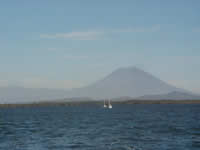 So,
we left Barillas at 9 am on Thursday morning January 10, four boats
in a line behind Luis in the Barillas panga, two headed south and
two headed North. So,
we left Barillas at 9 am on Thursday morning January 10, four boats
in a line behind Luis in the Barillas panga, two headed south and
two headed North.
Before we close,
we need to add, that the 2Cs did not leave El Salvador without making
what contribution we could to the still ongoing cruiser-based relief
program. The housing construction project, under the direction of
a cruiser named Dennis of the sv Knee Deep, is still in progress.
While we were there, it was in a lull while waiting funds to make
their way through complicated international banking networks, or
else Don would have been out there getting his hands dirty. Instead
we decided to make a donation to the local school. Although elementary
education is free in El Salvador, the textbooks and required uniforms
amount to about $35 per student per year, which, considering that
a typical daily salary is $4/day, stands in the way of many children
attending. We donated $200 to the local school earmarked to be spent
on just those kids (the $200 will fund approximately 7 students
for one year that might not otherwise get to go!). We also donated
a box of "Tackless-II-sailed-through" pencils. We can't
imagine a better use for them.
We just had an email from Celina and Max inviting us to come stay
at their home and try to work a short trip from there to Antigua,
Guatemala! Wouldn't that have been a special experience. Unfortunately,
we were already "out the door." However, Celina, knowing
that we had a particular interest in education, reported that the
President had just made an announcement making education mandatory
and providing that uniforms and books would be available to those
who couldn't afford them. If it actually happens, there could be
nothing better for the future of this country. At every turn, it
seemed to us that education would be the key. How fast and thoroughly
it will be implemented is another questions; we are sure our donation
will go to good use somehow.
Meanwhile, the
building program can still use help, so if any readers feel so moved,
we are including donation instructions here. An 18' x 20' single-family
dwelling can be built for $2000 and takes a cruiser team approximately
one week to erect. Such a dwelling has neither electricity or plumbing,
but it is a huge improvement over what they are accustomed to and
of much sounder construction. Dennis is expecting the current round
of funds to clear within the next week or so and a new influx of
cruisers to implement them over the next few months.
DONATION
INFORMATION FOR THE BARILLAS RELIEF PROJECT
(Donations made payable to the "Barillas Relief Project"
should be sent c/o St. Jude's Episcopal Church, 20920 McClellan
Road at Stelling, Cupertino, CA 95015-2967. Include your name and
address in order to receive a receipt for IRS purposes, and they
ask that you email to maljacholt@compuserve.com with the date and
amount of your contribution for accountability purposes. Monies
donated this way will end up helping the people its aimed at and
will not end up in the wrong people's pockets.)
|